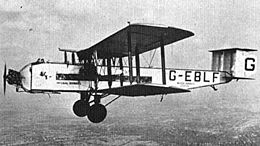- 1933 Imperial Airways Dixmude crash
-
City of Liverpool 
A similar Argosy of Imperial Airways in 1926.Accident summary Date 28 March 1933 Type Fire Site Near Dixmude, Belgium Passengers 12 Crew 3 Fatalities 15 (all) Survivors 0 Aircraft type Armstrong Whitworth Argosy II Aircraft name City of Liverpool Operator Imperial Airways Tail number G-AACI Flight origin Brussels Airport Destination Croydon Airport The City of Liverpool disaster was the fatal accident of an Armstrong Whitworth Argosy II aeroplane flown by British airline Imperial Airways named City of Liverpool on 28 March 1933 near Dixmude, northern Belgium after an onboard fire.[1] At the time it was the deadliest accident in the history of British civil aviation. It has been suggested that this was the first airliner ever lost to sabotage,[2] and in the immediate aftermath suspicion centred on one passenger, Dr. Albert Voss, who seemingly jumped from the aircraft before it crashed.
Accident
The aircraft was employed on Imperial's regular London-Brussels-Cologne route, which it had plied for the previous five years.[3] On this leg of the journey the plane was travelling from Brussels to London, which route would take it north from Brussels heading over Flanders Fields before crossing the coast for the 50-mile hop across the English Channel and then making the brief traverse over the Kent countryside to land at Croydon Airport in Surrey, a journey that was estimated to take two hours from the aircraft's slightly delayed take-off just after 12:30pm.[4]
While flying over the fields of northern Belgium, the aircraft was seen by onlookers on the ground to catch fire before losing altitude and plunging into the ground.[5][6] As the aircraft began its descent, a passenger was seen to exit the aeroplane and fall to earth parachute-less. He was subsequently identified as Dr Albert Voss, a German Jew who had emigrated to the United Kingdom where he practised as a dentist in Manchester.[6][7] Just before crashing, at approximately 200 feet, the aircraft split in two and the two separate portions of the aeroplane impacted the ground separately, instantly killing all those still on board.[8][9]
The subsequent investigation found that the fire had started towards the rear of the plane, in either the lavatory or the luggage area at the back of the cabin. No items recovered from the front portion of the aircraft after the crash showed any evidence of fire damage before the impact, nor was there any evidence of fire in the engines or fuel systems. The investigators narrowed the cause down to the firing of some combustible substance, either accidentally by a passenger or crew member or through vibration or some other natural occurrence, or deliberately by bombing.[10]
At the inquest into Voss's death at least one witness, Voss's estranged brother, accused him of being responsible,[5] claiming that Voss's business trips to the continent to buy anaesthetics masked a lucrative sideline in drug smuggling,[5] a rumour that had followed Voss for some time before his death and which had allegedly been the subject of investigations by the Metropolitan Police.[3] Voss's brother alleged that he and his partner (who was also travelling aboard the aircraft) were aware that the authorities were on to them, and that Voss sought to escape from the authorities by destroying the aircraft (using various flammable substances to which his job gave him easy access) he was travelling on and bailing out in the confused circumstances, hoping that in the confusion nobody would notice one less body than there should be.[5][11] An autopsy of his corpse showed that, other than some minor burns, Voss was unharmed before he left the aircraft.[12][13] The inquest jury eventually returned an open verdict (a verdict that the jury has suspicions that the death may not be accidental but is unable on the evidence before them to come to an explicit conclusion that this is so), rather than the verdict of accidental death the coroner attempted to direct them towards.[14]
References
- ^ The Times (46405). 29 March 1933.
- ^ Denham, Terry. World Directory of Airliner Crashes. Yeoford: Patrick Stephens Ltd. p. 21. ISBN 1 85260 554 5.
- ^ a b Barker (1988) p. 56
- ^ Barker (1988) p. 57
- ^ a b c d "Foreign News: Dr. Voss". Time. Time Inc. 17 April 1933. http://www.time.com/time/magazine/article/0,9171,847288,00.html. Retrieved 24 April 2010.
- ^ a b Barker (1988) p. 58
- ^ Barker (1988) p. 55
- ^ "ASN Wikibase Occurrence # 949". Aviation Safety Network. Flight Safety Foundation. http://aviation-safety.net/wikibase/wiki.php?id=949. Retrieved 22 December 2010.
- ^ Barker (1988) pp. 59-60
- ^ Barker (1988) pp. 60-61
- ^ Barker (1988) pp. 61-62
- ^ Barker (1988) p. 59
- ^ Barker (1988) p. 63
- ^ Barker (1988) pp. 63-64
- Barker, Ralph (1988) [First edition published 1966]. "The World of Albert Voss". Great Mysteries of the Air (Revised ed.). London, United Kingdom: Javelin. ISBN 0-7137-2063-8.
← 1932 · Aviation accidents and incidents in 1933 · 1934 → 28 Mar Imperial Airways Dixmude crash
4 Apr USS Akron17 Jul Lituanica
15 Aug Pan Am General Machado
4 Sep Florence Klingensmith10 Oct United Airlines Chesterton crash
30 Dec Imperial Airways Ruysselede crashIncidents resulting in at least 50 deaths shown in italics. Deadliest incident shown in bold smallcaps.Categories:- Accidents and incidents involving airliners
- Airliner accidents and incidents with an unknown cause
- Aviation accidents and incidents in 1933
- In-flight aircraft fires
- Aviation accidents and incidents in Belgium
- Imperial Airways accidents and incidents
Wikimedia Foundation. 2010.
